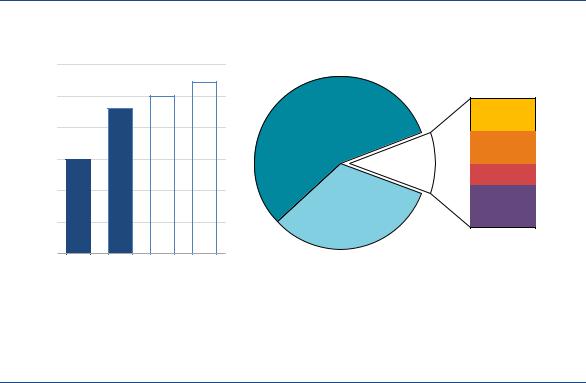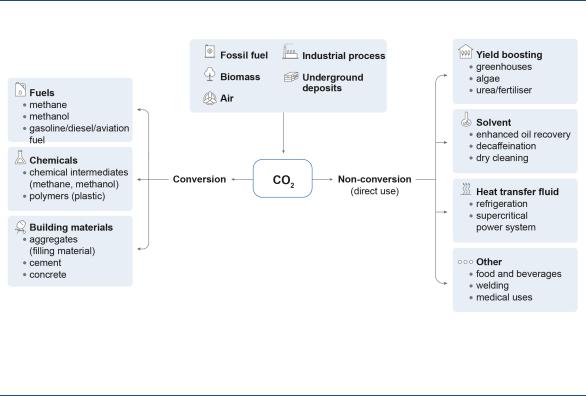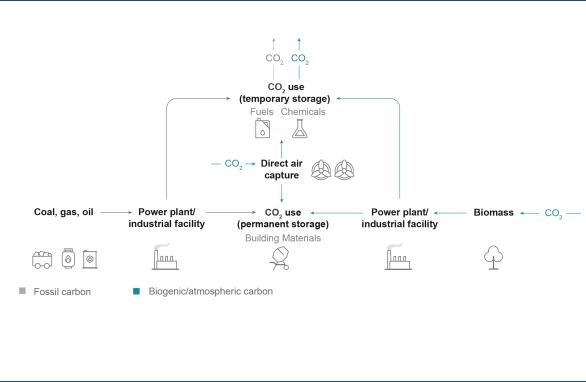
- •Putting CO2 to Use
- •Abstract
- •Highlights
- •Executive summary
- •CO2 is a valuable commodity
- •Early markets are emerging but the future scale of CO2 use is uncertain
- •Using CO2 can support climate goals, but with caveats
- •Cultivating early opportunities while planning for the long term
- •Findings and recommendations
- •Millions of tonnes of CO2 are being used today
- •New pathways for CO2 are generating global interest
- •CO2 use can contribute to climate goals, but with caveats
- •The future scale of CO2 use is highly uncertain
- •Where are the emerging market opportunities?
- •1. CO2-derived fuels
- •2. CO2-derived chemicals
- •3. Building materials from minerals and CO2
- •4. Building materials from waste and CO2
- •5. Crop yield boosting with CO2
- •CO2 use can complement CO2 storage, but is not an alternative
- •References
- •Policy recommendations
- •Technical analysis
- •Introduction
- •Setting the scene
- •What is CO2 use?
- •CO2-derived fuels
- •CO2-derived chemicals
- •CO2-derived building materials
- •Where is CO2 being used today?
- •What has spurred renewed interest in CO2 use?
- •Who is currently investing in CO2 use, and why?
- •How can CO2-derived products and services deliver climate benefits?
- •Understanding the future market for CO2-derived products and services
- •Which factors influence the future market?
- •Scalability
- •Competitiveness
- •The price and availability of hydrogen
- •The price and availability of CO2
- •Climate benefits
- •Origin of the CO2
- •Displaced product or service (reference system)
- •Energy input
- •Retention time of carbon in the product
- •Is it possible to assess the future market size?
- •Scaling up the market
- •CO2-derived fuels
- •What are CO2-derived fuels?
- •Are CO2-derived fuels scalable?
- •Under what conditions would CO2-derived fuels be competitive?
- •Can CO2-derived fuels deliver climate benefits?
- •What are the regulatory requirements?
- •CO2-derived chemicals
- •What are CO2-derived chemicals?
- •Are CO2-derived chemicals scalable?
- •Under what conditions would CO2-derived chemicals be competitive?
- •Can CO2-derived chemicals deliver climate benefits?
- •What are the regulatory requirements?
- •CO2-derived building materials from natural minerals
- •What are CO2-derived building materials?
- •Are CO2-derived building materials scalable?
- •Under what conditions would CO2-derived building materials be competitive?
- •Can CO2-derived building materials deliver climate benefits?
- •What are the regulatory requirements?
- •CO2-derived building materials from waste
- •What are building materials made from waste?
- •Are building materials from waste scalable?
- •Under what conditions are building materials from waste competitive?
- •Can building materials from waste deliver climate benefits?
- •What are the regulatory requirements?
- •CO2 use to enhance the yield of biological processes
- •What is yield boosting?
- •Is CO2 yield boosting scalable?
- •Under what conditions is CO2 yield boosting competitive?
- •Can CO2 yield boosting deliver climate benefits?
- •What are the regulatory requirements?
- •Where are suitable locations for an early market?
- •Implications for policy
- •Public procurement
- •Mandates
- •Economic incentives
- •Labelling, certification and testing
- •Research development and demonstration
- •Recommendations
- •References
- •General annex
- •Abbreviations and acronyms
- •Acknowledgements
- •Table of contents
- •List of figures
- •List of boxes
- •List of tables

Putting CO2 to Use: Creating Value from Emissions |
Findings and recommendations |
Findings and recommendations
Policy recommendations
•Ensure policy and investment decisions for CO2 use applications are informed by robust lifecycle analysis that provides improved understanding and quantification of climate benefits.
•Identify and enable early market opportunities for CO2 use that are scalable, commerciallyfeasible and can deliver emissions reductions. The use of CO2 in building materials is one such opportunity.
•Introduce public procurement guidelines for low-carbon products. This can create an early
market for CO2-derived products with verifiable CO2 emissions reductions, and promote innovation and investment.
•Establish performance-based standards for products such as building materials, fuels and chemicals to facilitate the uptake of CO2-derived alternatives.
•Support research, development and demonstration for future applications of CO2 use that could play a role in a net-zero CO2 emission economy, including as a carbon source for aviation fuels and chemicals.
Millions of tonnes of CO2 are being used today
While most of the focus on CO2 is on its contribution to climate change, it can also be a commercial input to a range of products and services. Today, around 230 million tonnes (Mt) of CO2 are used each year (IHS Markit, 2018). The largest consumer is the fertiliser industry, where around 130 MtCO2 per year is used in urea manufacturing, followed by the oil sector, with a consumption of 70 to 80 MtCO2 for enhanced oil recovery (EOR) (IEA, 2019a). CO2 is also widely used in food and beverage production, the fabrication of metal, cooling, fire suppression and in greenhouses to stimulate plant growth.
More than two-thirds of current global demand for CO2 comes from North America (33%), the People’s Republic of China (“China”) (21%) and Europe (16%), with the demand for existing uses expected to grow steadily year-on-year (Figure 1). This analysis does not consider these mature CO2 use pathways, including EOR, but focuses on its emerging and novel applications.
PAGE | 5
IEA. All rights reserved.

Putting CO2 to Use: Creating Value from Emissions |
Findings and recommendations |
Figure 1. Growth in global demand of CO2 over the years (left); breakdown of demand in 2015 (right)
|
300 |
|
272 |
|
|
|
|
|
250 |
|
250 |
|
|
230 |
|
|
|
|
|
/yr |
200 |
|
Beverages (3%) |
|
Urea (57%) |
||
2 |
|
||
MtCO |
150 |
150 |
Food (3%) |
|
|||
|
|
|
|
|
|
|
Fab. metal (2%) |
100
Other (4%)
50 |
EOR (34%) |
|
0
2000 2015 2020 2025
Note: Projections for future global CO2 demand are based on an average year-on-year growth rate of 1.7%.
Sources: Analysis based on ETC (2018), Carbon Capture in a Zero-Carbon Economy; IHS Markit (2018), Chemical Economics Handbook – Carbon Dioxide; US EPA (2018), Inventory of U.S. Greenhouse Gas Emissions and Sinks 1990-2016.
Global consumption of CO2 is estimated to be 230 Mt/yr and expected to grow steadily over the coming years; consumption is mainly driven by EOR and on-site demand for urea production.
New pathways for CO2 are generating global interest
The range of potential CO2 use applications is very large and includes direct use, by which CO2 is not chemically altered (non-conversion) and the use of CO2 by transformation (via multiple chemical and biological processes) to fuels, chemicals and building materials (conversion) (Figure 2).
Although most conversion pathways are highly energy-intensive and still in their infancy, they are attracting growing interest and support from governments, industry and investors. Companies such as CarbonCure and Solidia, which use CO2 to manufacture concrete, have recently attracted investment from Breakthrough Energy Ventures and OGCI Climate Investments, respectively. In North America, the NRG COSIA Carbon XPrize is supporting the development of novel CO2 use opportunities with a USD 20 million global competition (XPRIZE, 2019). Governments in Canada, Japan, the United Kingdom and the United States as well as the European Commission are also providing significant RD&D support for CO2 use.
The emerging interest in opportunities for the use of CO2 is driven by several concerns. Key among these is its potential to contribute to climate goals. Other factors include technology leadership, energy security, the anticipated availability of cheap and abundant renewable energy (which could make CO2 conversion routes more economical), and the potential for the use of CO2 to be either a stepping stone or a smaller-scale alternative to carbon capture and storage (CCS).
In select cases, such as building materials, the use of CO2 can be based on purely commercial drivers as it delivers a product with superior performance and lower cost than conventionally produced building materials. CO2 could be an important raw material for products that will
PAGE | 6
IEA. All rights reserved.

Putting CO2 to Use: Creating Value from Emissions |
Findings and recommendations |
continue to require carbon, either because it provides their structure and properties (carboncontaining chemicals) or because the use of carbon-free energy carriers, such as electricity or hydrogen, is challenging (for example, aviation fuels). CO2 is one of few alternatives to fossil fuel as a source of carbon.
Figure 2. Simple classification of pathways for CO2 use
IEA 2019. All rights reserved.
CO2 can be used in a broad range of applications involving direct use of CO2 or use through conversion into other products.
CO2 use can contribute to climate goals, but with caveats
Using CO2 in products or services does not necessarily reduce emissions. Quantifying the potential climate benefits is complex and challenging, requiring a life cycle approach. The climate benefits associated with CO2 use primarily arise from displacing a product or service with one that has higher life-cycle CO2 emissions, such as fossil-based fuels, chemicals or conventional building materials.
There are five key considerations in assessing the climate benefits of CO2 use:
1.the source of CO2 (from natural deposits, fossil fuels, biomass or the air)
2.the product or service the CO2-based product or service is displacing
3.how much and what form of energy is used to convert the CO2
4.how long the carbon is retained in the product
5.the scale of the opportunity for CO2 use.
PAGE | 7
IEA. All rights reserved.

Putting CO2 to Use: Creating Value from Emissions |
Findings and recommendations |
Over time, and as fossil fuel use declines, the climate benefits associated with displacement will be reduced and the CO2 used must increasingly be sourced from biomass or through direct air capture (DAC). These CO2 sources can support a carbon-neutral life cycle for some CO2 use applications and could deliver negative emissions in applications where the carbon is permanently stored, such as in building materials (Figure 3). However, these negative emission opportunities are likely very limited and must be considered in the context of the product’s entire life cycle.
The carbon retention time for CO2 use applications can vary per product, ranging from less than one year for fuels, up to ten years for most chemical intermediates, to hundreds of years for polymers, while storage in building materials could last for millions of years. Critically, the potential of CO2 use to contribute to climate goals will depend on how far, and how fast, these opportunities can be scaled-up.
Figure 3. CO2 flows for CO2 use applications
IEA 2019. All rights reserved.
The climate benefits associated with CO2 use will depend on several factors, including the source of CO2, the product being displaced, and the retention of CO2 in the final product.
The future scale of CO2 use is highly uncertain
The future market for CO2-derived products and services is very difficult to assess, reflecting the early stage of technology development for many applications and the reliance on supporting policy frameworks. Global estimates range from less than 1 GtCO2 per year to 7 GtCO2 per year by 2030, depending on the assumptions applied. These higher estimates are considered extremely optimistic.
A high-level screening of the theoretical potential for CO2 use and the likely climate benefits (Figure 4) shows that fuels have the largest potential due to their vast market size, while building materials show the greatest climate change mitigation potential mainly because of the low energy requirements and the permanent retention of carbon in the product.
PAGE | 8
IEA. All rights reserved.
